| Reviews & Columns |
|
Reviews DVD TV on DVD Blu-ray 4K UHD International DVDs In Theaters Reviews by Studio Video Games Features Collector Series DVDs Easter Egg Database Interviews DVD Talk Radio Feature Articles Columns Anime Talk DVD Savant Horror DVDs The M.O.D. Squad Art House HD Talk Silent DVD
|
DVD Talk Forum |
|
|
| Resources |
|
DVD Price Search Customer Service #'s RCE Info Links |
|
Columns
|
|
|
True Heart Susie & Hoodoo Ann
David Shepard has produced another disc of silent movie classics, and like his other efforts, this one is worth checking out. This time around we are treated to a pair of films that were made in association with film pioneer D. W. Griffith and that both feature actor Robert Hardon in supporting roles.
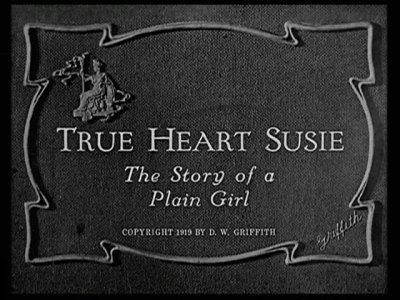
The first is 1919's True Heart Susie, one of Griffith's "short story series". Griffith had stopped making the grand epic pictures that he is remembered for by this time and was concentrating on more intimate and personal movies. This film shows that he was just as capable in directing smaller pictures as he was with big budget extravaganzas.
The second feature is Hoodoo Ann (1916), a Mea Marsh vehicle that was directed by Lloyd Ingraham from a Griffith Script. This movie actually feels more like a Griffith production that True Heart Susie. It has a spectacular fire scene as well as several unique innovative touches that help the movie overcome the rather awkward script.
True Heart Susie:
Susie (Lillian Gish) is a plain and unimpressive girl who has fallen in love with a classmate, William (Robert Hardon). William desperately wants to go to college but he doesn't have the money, so Susie comes up with a plan: She sells the cow and other livestock that she inherited from her mother and sends the money anonymously to the man she loves. William assumes that it's from a rich man he met in town one day and happily goes off to the local university.
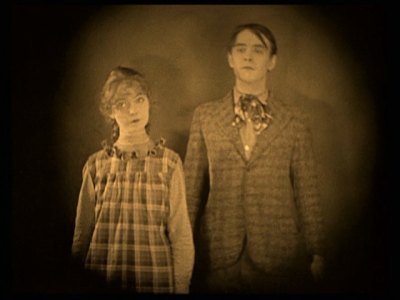 He comes back a few years later, educated and worldly. Susie is elated to see him once again, but William has grown past her. He ends up falling for a more modern girl from Chicago who does herself up with "paint and powder," Bettina Hopkins (Clarine Seymour), and eventually marries her. Susie is heartbroken but even so she does not reveal her secret, preferring to suffer in silence rather than ruin William's happiness.
He comes back a few years later, educated and worldly. Susie is elated to see him once again, but William has grown past her. He ends up falling for a more modern girl from Chicago who does herself up with "paint and powder," Bettina Hopkins (Clarine Seymour), and eventually marries her. Susie is heartbroken but even so she does not reveal her secret, preferring to suffer in silence rather than ruin William's happiness.
Bettina doesn't love William however. She's just looking for a sap to support her while she goes on flirting with all the other men in town. Susie realizes that Bettina is being unfaithful, but her pure nature can't allow her to tell William about it. With her love married to a cheating hussy, how will poor Susie ever find happiness?
This was a well done character driven romance, and the major actors did a very good job with their parts, but I had a hard time really getting into it. William comes across as a pretty shallow individual and not too bright either. Though I could understand Susie having a schoolgirl crush on him, I thought that she'd be better off with someone else.
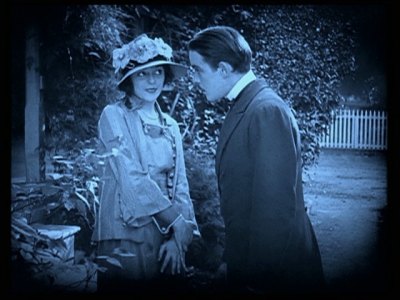 Some of that feeling is due to the fact that the America of today is very different from that of 1919. The movie's a bit dated in that respect and feels a bit odd in parts. In the introduction to the movie, a card stated that "Woman is supposed to be allowed her choice - any yet, not one in ten ever has a chance to marry any but one man."
Some of that feeling is due to the fact that the America of today is very different from that of 1919. The movie's a bit dated in that respect and feels a bit odd in parts. In the introduction to the movie, a card stated that "Woman is supposed to be allowed her choice - any yet, not one in ten ever has a chance to marry any but one man."
While the plot is fairly simple, it's not very tight and the story is a bit contrived in places. There are some plot points that come out from nowhere and feel very awkward. The rich man driving through town in his car is a good example. As everyone gathers around to marvel at his automobile the man picks William out from the crowd, asks his name and address and promises him that he'll "aid" the young man in some unspecified way. Of course he's never heard from again. Where did this come from and why does he go around raising the hopes of young men only to dash them? The conclusion came about in a similar way. The writers needed some way to get Bettina out of William's life, so they manufactured something, even if it wasn't too realistic.
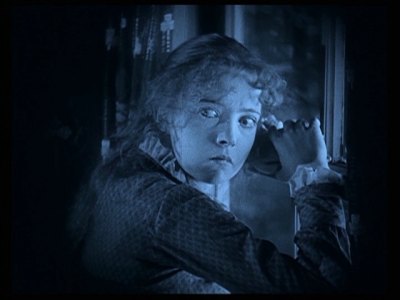 This is a character driven film though, and the solid performances is the movie's selling point. Lillian Gish does a fairly good job though I don't think this is her best work. She is a bit stiff in her close-ups and medium shots. She's trying to look 'plain' and does this by tilting her head to the right and putting her hair in pigtails, and having a vacant look on her face most of the time. She has such a beautiful face though it's hard to think of her as being unattractive. When the script calls for her to act she does a fantastic job. When she finds out that William is going to marry Bettina, after thinking otherwise, you can see her heart break just by the look on her face. A simple twitch of the mouth and a slightly raised eyebrow is all it takes.
This is a character driven film though, and the solid performances is the movie's selling point. Lillian Gish does a fairly good job though I don't think this is her best work. She is a bit stiff in her close-ups and medium shots. She's trying to look 'plain' and does this by tilting her head to the right and putting her hair in pigtails, and having a vacant look on her face most of the time. She has such a beautiful face though it's hard to think of her as being unattractive. When the script calls for her to act she does a fantastic job. When she finds out that William is going to marry Bettina, after thinking otherwise, you can see her heart break just by the look on her face. A simple twitch of the mouth and a slightly raised eyebrow is all it takes.
Clarine Seymour nearly steals the picture as the vamp. Yes, she overplays the role and hams it up at times, but she does it with such enthusiasm that it's impossible not to enjoy her performance. Every time she's on the screen the movie becomes much more interesting. She would have surely become a bigger star had she not died due to complications while having an operation the following year.
Griffith crafted a solid movie. He used a varitey of shots, close, medium, and long, to tell the story which had become standard practice by this point in time. There weren't as many interesting shots as I thought there would be. Most Griffith films have at least one or two sequences that really stand out, but nothing really jumps out of this movie. The one thing that is hard not to notice is how often he shot through an iris. It seems like every other shot is presented in a circle. While this was a common technique at the time, Griffith tends to overuse it in this picture.
Hoodoo Ann:
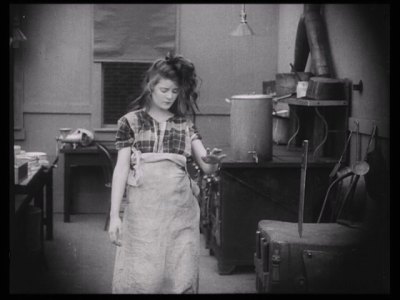 Poor Ann (Mea Marsh). She was dropped off at an orphanage as an infant, and has had bad luck ever since. For reasons that are never explained, no one at the orphanage likes her. The matrons who run the house work her like a slave while the other boys and girls play outside. Even at night when the girls are being tucked in, everyone gets a goodnight kiss except Ann. Her only friend is the Negro cook, Black Cindy (Madame Sul-Te-Wan) who reads the girl's palm one evening and states that "You'll be hoodooed all your life-till your married."
Poor Ann (Mea Marsh). She was dropped off at an orphanage as an infant, and has had bad luck ever since. For reasons that are never explained, no one at the orphanage likes her. The matrons who run the house work her like a slave while the other boys and girls play outside. Even at night when the girls are being tucked in, everyone gets a goodnight kiss except Ann. Her only friend is the Negro cook, Black Cindy (Madame Sul-Te-Wan) who reads the girl's palm one evening and states that "You'll be hoodooed all your life-till your married."
The plot abruptly changes about half way through the film. The orphanage burns down and the various children are farmed out to different families until a more permanent home can be found for them. The family that Ann is staying with likes her so much that they decide to adopt her. Time passes and Ann grows to be a fine young woman. She has her heart set on the boy next door, Jimmie (Robert Hardon), and he likes her, but her Hoodoo curse kicks in again.
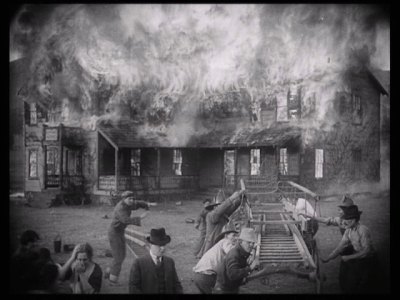 After seeing a movie with Jimmie where a woman saves her man by shooting it out with the bad guys, Ann decides she wants to be a movie star. She dresses up like the actor and acts out scenes from the movie but has the bad judgment of using a real gun. It goes off and shoots into a neighbor's house. Ann looks in and sees a man lying on the floor and is sure she's killed him. How can she ever marry Jimmie when she's guilty of murder?
After seeing a movie with Jimmie where a woman saves her man by shooting it out with the bad guys, Ann decides she wants to be a movie star. She dresses up like the actor and acts out scenes from the movie but has the bad judgment of using a real gun. It goes off and shoots into a neighbor's house. Ann looks in and sees a man lying on the floor and is sure she's killed him. How can she ever marry Jimmie when she's guilty of murder?
This movie is a big mess and hard to defend. The plot is disjointed with many aspects that are never explained (what happened to the doll that Ann stole?), there isn't much attention to detail (all of the boys in the orphanage are about 10 years old while all of the girls look 18), and Hardon is barely in the film. Even with all of this however, I really enjoyed this movie.
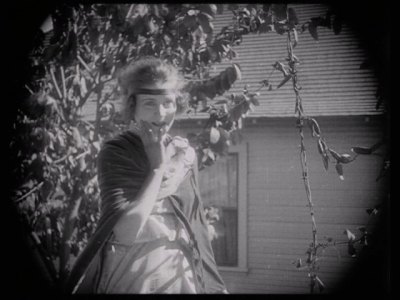 The film consists of several interesting scenes that are stitched together. I wouldn't be surprised to learn that this was the way it was written, with the individual scenes coming first and the overall plot second. Though he only produced and scripted the film, it isn't hard to see D. W. Griffith's influence on this movie. The fire was big and spectacular something that Griffith would enjoy doing, and the section where Ann and Jimmie go to the movies and watch a film was interesting and a lot of fun too.
The film consists of several interesting scenes that are stitched together. I wouldn't be surprised to learn that this was the way it was written, with the individual scenes coming first and the overall plot second. Though he only produced and scripted the film, it isn't hard to see D. W. Griffith's influence on this movie. The fire was big and spectacular something that Griffith would enjoy doing, and the section where Ann and Jimmie go to the movies and watch a film was interesting and a lot of fun too.
The one scene that really stands out however is Jimmie and Ann's first kiss. After a date the pair are holding hands on Ann's porch. Jimmie pulls the girl to the right until he's off the screen. She pulls him back to the centre and then disappears off to the left side herself. He leans towards her until you can't see his head, and then runs off a moment later. Ann slowly walks to the center of the screen with a pleasant look on her face. This scene is a wonderful bit of film making.
The DVD:
Audio:
The score for the feature film was performed by the Mont Alto Motion Picture Orchestra from a score compiled by the group's pianist, Rodney Sauer. They do their usual excellent job, both musically and having the music fit the tone of the movie. Hoodoo Ann is presented with a piano score that Mr. Sauer compiled and plays. This too was very good and the solo piano fit the simple feeling of the movie. Mr. Sauer also realizes that less can be more and in some scenes has very minimal music. The section where Ann breaks a doll that she's 'borrowed' is like that, and the lack of energetic playing accented the scene well. Since these are recent recordings there are no audio defects. The sound is strong and clear.
Video:
This disc was put together by David Shepard of Film Preservation Associates/Blackhawk Films, and he's created another excellent looking package. True Heart Susie was restored by the British Film Institute (BFI) from a 35mm negative of the film, and the tinting scheme was taken from an original print, also at BFI. The sepia toned and tinted 1.33:1 image (slightly window boxed to make up for overscan) looks excellent. The restored print did have some damage present, scratches and some dirt, and there were a couple of instances of missing frames too. The quality of the image made up for these defects however. The contrast was excellent and the detail was very good, especially for a film that's over 85 years old. The wood grain on the picket fence in front of Susie's house is easy to make out, and even the patterns on the rugs and carpets are clear. A few of the highlights are washed out, but this isn't a major defect at all. There are some digital flaws, some aliasing and a few instances where a pin-stripped suit jitters, but overall this is an impressive effort.
The second feature, Hoodoo Ann, looked just as good. It was also restored by the BFI from a fine-grain positive which was struck from the camera negative. Though this film wasn't tinted or sepia toned, the black and white 1.33:1 image was also very pleasing to the eye. There were a wide range of gray tones, very nice contrast, and an excellent level of detail. The blacks were a little light, but there wasn't any blooming in the scenes filled with white. There are a couple of rough patches where the print was heavily scratched, but these pass quickly.
Extras:
There's a really neat bonus item for people who are interested in the score used for the main feature. Rodney Sauer, who complied the score, has written a short piece on the music that he used. In addition he also included a list of songs, with their composers and publication dates, which were used in creating the score. I don't recall seeing this before and think it's a great idea.
Final Thoughts:
Both of these films are fun and enjoyable. I actually had a better time watching Hoodoo Ann, though I'll be the first to admit that the movie has a lot of flaws. Most viewers will probably prefer True Heart Susie which features a very good performance by Lillian Gish. This is also a rare opportunity to see Clarine Seymour on film. She nearly stole the show with her perky and over-the-top performance. It's a shame that she died soon after making this film.
Both movies look marvelous too. The restored prints, courtesy of BFI, have a lot of detail and a wonderful level of contrast. The scores by the Mont Alto Orchestra and Rodney Sauer are also very enjoyable and add a lot to the package. This is a nice pair of films that get a strong recommendation.
|
| Popular Reviews |
| Sponsored Links |
|
|
| Sponsored Links |
|
|
| Release List | Reviews | Shop | Newsletter | Forum | DVD Giveaways | Blu-Ray | Advertise |
|
Copyright 2024 DVDTalk.com All Rights Reserved. Legal Info, Privacy Policy, Terms of Use,
Manage Preferences,
Your Privacy Choices | |||||||













